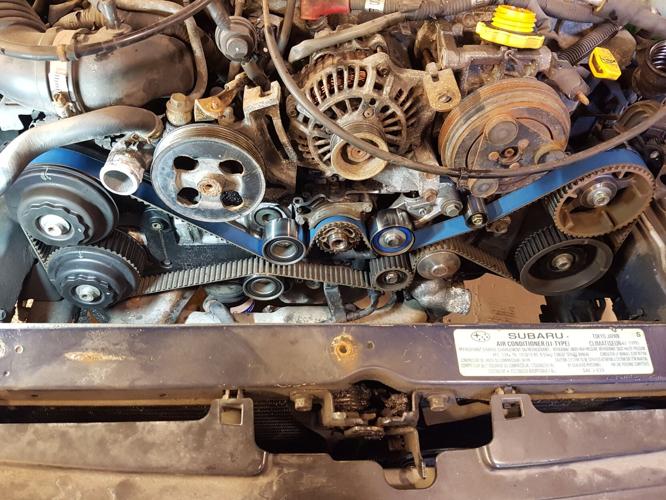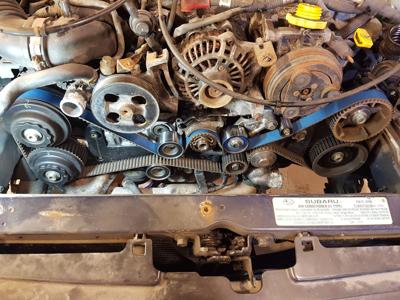Dear Ask a Mechanic,
The mechanic at the garage we take our 2020 (Honda) Passport to is telling me that we should be replacing the timing belt soon, even though the vehicleÔÇÖs maintenance system isnÔÇÖt calling for it.
He says that HondaÔÇÖs recommendation for years has been for Canadian vehicles to use the shorter ÔÇťsevere dutyÔÇŁ schedule of 96,000 km (WeÔÇÖve just reached 100,000.) He says that if it ever broke, it would cause major engine damage.
ItÔÇÖs a fairly expensive job, especially as heÔÇÖs suggesting the water pump get changed at the same time.
Can we put this off and save up, or is he right?
Why on earth did Honda even use a belt that needs changing? Apparently the CR-V we owned before this didnÔÇÖt use one.
Cam Sprocket
Your Passport, like virtually every road-going vehicle with an internal combustion engine, whether hybrid or not, has valves that open and close to facilitate the movement of air in, and exhaust out, of the cylinder, as the piston moves through its various strokes.
The timing of those valve operations in relation to the pistonÔÇÖs position is critical to the operation and performance of the engine. Lobes (raised bits on a camshaft that, as the shaft rotates, lift and lower the valves)┬áÔÇö your PassportÔÇÖs V6 has two ÔÇö mechanically actuate the valves through some form of valve-train, and itÔÇÖs these camshafts that must rotate in precise half-speed synchronization with the crankshaft for the whole thing to work.
There are a few ways to make this happen. Most engines use either a belt or one or more chains to accomplish the same goal.
Belts weigh less and create less drag (improving efficiency), are typically less noisy, wear or stretch less, to the benefit of continued timing accuracy with age and use, further maintained by periodic replacement, and are probably less costly to engineer and produce.
Chains, on the other hand, are theoretically maintenance-free, and as they are lubricated by oil already, simplify variable cam timing design (when used), as the oil-operated cam phasers donÔÇÖt have to be sealed perfectly┬áas they do on belt drives.
Chains can be more compact than a comparable belt drive. They also have improved torque capacity for driving things such as the high-pressure fuel pumps needed for direct injection.
HondaÔÇÖs decision to use a timing belt on its V6 engine family, rather than a chain as in your CR-VÔÇÖs four cylinder, could be for any or all of these reasons.
The frequency of timing belt maintenance varies considerably among applications; the same engine may have different requirements, depending on the model year or specific vehicle itÔÇÖs in, and a 96,000-kilometre service life is not uncommon.
Timing belts are often forgotten, and many a belt has outlived its makerÔÇÖs suggested lifespan, sometimes by many times.
But letting things roll indefinitely is a pretty serious gamble.
The overwhelming majority of modern engines are whatÔÇÖs known as ÔÇťinterference,ÔÇŁ meaning that, at various times, the heads of the valves, when fully open, occupy the same space inside the cylinder as the top of the piston. When properly timed, the two components arenÔÇÖt there at the same time. When the timing goes awry via a badly skipped or broken belt or chain, well┬áÔÇŽ┬áwhammo!
Usually one, or more, of the valves gets bent, necessitating cylinder-head removal and repairs. Sometimes pistons get damaged, too, at which point engine-rebuilding or -replacement makes the most sense.
Suddenly a belt seems inexpensive┬áÔÇŽ.
The OwnerÔÇÖs Manual for your Passport does suggest that, if used ÔÇťregularlyÔÇŁ in extreme temperatures (over 43C or under -29C), a 100,000-km interval should be the measure to follow.
Unless you live in an area with those weather conditions, IÔÇÖd speculate that your technician is simply following what was once standard practice for earlier versions of the J-series V6. Improved belt materials and construction reduce this need today.
You should, therefore, be able to defer the belt until the manufacturerÔÇÖs system calls for it (Item 4, along with spark plugs). I agree about changing the (timing-belt-driven) water pump at that time, as it requires little extra labour with the belt removed and it has a similar life expectancy. Use a factory equivalent part ÔÇö IÔÇÖve experienced a high failure rate with aftermarket pumps in Honda/Acura V6s.
Ask a Mechanic is written by Brian Early, a Red Seal-certified Automotive Service Technician. You can send your questions to wheels@thestar.ca. These answers are for informational purposes only. Please consult a certified mechanic before having any work done to your vehicle.





























To join the conversation set a first and last name in your user profile.
Sign in or register for free to join the Conversation